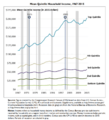Economy of the United States facts for kids
The economy of the United States is the world's largest national economy and the world's second-largest overall economy, the GDP of the European Union being approximately $2 trillion larger. Its nominal GDP was estimated to be $21.4 trillion in 2019, approximately a quarter of nominal global GDP. Its GDP at purchasing power parity is the largest in the world, approximately a fifth of global GDP at purchasing power parity.
Images for kids
-
Washburn and Moen Manufacturing Company in Worcester, Massachusetts, 1876
-
Oil wells at Los Angeles, California, 1905
-
Consolidated B-24 Liberators at the Consolidated-Vultee Plant, Fort Worth, Texas, 1943
-
McDonald's restaurant in Mount Pleasant, Iowa
-
U.S. share of income (pre-tax and after-tax) earned by top 1% households in 1979, 2007, and 2015 (CBO data). The first date (1979) reflects the more egalitarian pre-1980 period, 2007 was the peak inequality of the post-1980 period, and the 2015 number reflects the Obama tax increases on the top 1% along with residual effects of the Great Recession.
-
Aerial view of San Diego suburb
-
Wealth inequality in the United States increased from 1989 to 2013.
-
Protectionist measures since 2008 by country.
-
The Federal Reserve is the central banking system of the United States
-
Boeing CEO Dennis Muilenburg at the 787-10 Dreamliner rollout ceremony
-
Restaurants and shops in Chinatown, Philadelphia
-
Percent of U.S. economy from State-owned Enterprises or GSEs
-
Tennessee in 1897. The U.S. was a leader in the adoption of electric lighting
-
Steve Jobs and Bill Gates are two of the best-known American entrepreneurs.
-
A typical Walmart discount department store (location: Laredo, Texas).
-
The New York Stock Exchange is the largest stock exchange in the world.
-
Contributions to Percent Change in Real GDP (1930–1946), source Bureau of Economic Analysis
-
Contributions to Percent Change in Real GDP (1947–1973), source Bureau of Economic Analysis
-
Contributions to Percent Change in Real GDP (1974–1990), source Bureau of Economic Analysis
-
Contributions to Percent Change in Real GDP (1991–2008), source Bureau of Economic Analysis
-
US share of world GDP (%) since 1980. US share of world GDP (nominal) peaked in 1985 with 32.74% of global GDP (nominal). The second-highest share was 32.24% in 2001. US share of world GDP (PPP) peaked in 1999 with 23.78% of global GDP (PPP). The share has been declining each year since then.
-
Gini Coefficient for Household Income (1967–2007), source United States Chamber of Commerce
-
Liabilities of the United States as a fraction of GDP 1960–2009
-
Development of U.S. federal government debt ceiling from 1990 to January 2012.
See also
 In Spanish: Economía de los Estados Unidos para niños
In Spanish: Economía de los Estados Unidos para niños



































































